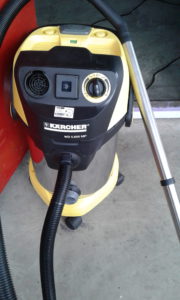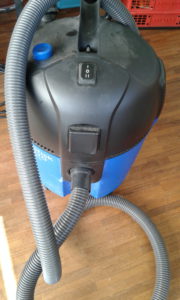Or: Some heroes wear nozzles!

Kärcher WD 5.600 MP
As the name suggest, they are usually outfitted to do both: to vacuum water AND dry stuff. But here’s the thing: they can only do one of those things at once. Therefore, it’s usually preferable to assign one vacuum cleaner for wet-only use. If you can’t afford two vacuum cleaners, I’d suggest making sure this one is always emptied at the end of the working day, so you don’t accidentally end up with a tank full of muddy dust, grime and sawdust that is nearly impossible to empty.
Now, what should you consider when buying a wet-dry vacuum cleaner? They come in a wide range of prices and functionalities, so it is like always a big “depends”. But here are some thoughts:
Capacity is often a big factor for the price, so you should ask yourself which scenario is most likely to happen. The occasional leaking roof is a big risk for the artifacts but usually just leaves small water puddles. So, a small tank with a capacity of only 10 to 20 liters will probably be enough, even if it means you have to go a few times and empty it. If your usual suspect is an insufficient drain system that leads to water coming back from the sinks and the toilets (yuck!) as soon as there is slightly more rain than usual, you probably need a larger tank. If this happens on a regular basis or large amounts of water are involved, you might want to look for a sump pump and the installation of a backflow trap.

Nilfisk Alto Aero 25
Speaking of wheels: if you do have to move your vacuum cleaner over larger distances and uneven ground how good the wheels are and how easy it is to move around can also be a determining factor in your buying decision.
One thing closely related to handling is the response time. As I said at the beginning it’s always best to have your vacuum cleaner for wet-only use. But if you can’t have one what it takes to convert your dry into a wet vacuum cleaner can determine your decision. For example: With my blue one, I have to remove the filter bag and the filter cartridge and put a special textile bag which serves as a fine filter over the motor before I can vacuum water. If I miss that step, I will destroy the vacuum cleaner. With the yellow one I’m good to go as soon as I have removed the filter bag. I do have to remember, however, that in this case I’m NOT allowed to remove the filter cartridge as it is necessary to protect the motor and if I do it like I would do with my vacuum cleaner at home I would inevitably destroy the device.
Closely related is the question if the vacuum cleaner can be operated in all corners of your storage or museum. So, how long the power cord is can be a factor in your decision. But even if your vacuum cleaner does have a rather long power cord, chances are that it is still not sufficient for that special far away corner of your storage. You may want to test out the action radius of your vacuum cleaner BEFORE the first incident and want to store it together with a cable drum of sufficient length.
Another important question is maintenance. This involves how easy it is to clean and to repair. You sometimes see no-name vacuum cleaners at a bargain price, but you should take a close look at the parts that are most likely to get lost or broken. The nozzles, for example, should be a standard size you get in every DIY store, not some exotic caliber that is a standard in the North-Western Black Forest. Same with the bags, filters and screws. All parts should be easy to disassemble and clean because you will inevitably suck some strange thing in that will get stuck half way in the hose. In that case it should be easy to remove the hose and clean it.
Some “Gotcha!” things are not so obvious: For example, I talked about leaving the filter cartridge in place with our yellow one. Now, here’s the thing: Of course, the cartridge, which is made of some sturdy paper plastics mixture, gets wet when I vacuum water. In order to dry it, I have to remove it after use. One thing is that I have to remember to put it back or the next one who uses the vacuum cleaner will destroy it. And the other is that I’m not completely comfortable having a soaking wet paper thingy around my storage because I always fear mold. I probably consider how this problem is solved in future purchases.
Your own vacuum cleaner will probably need some special skills we haven’t considered so far. Maybe you do have a lot of water in your storage occasionally but also sometimes only small puddles. In this case you might want to look for a vacuum cleaner which can also be operated as a pump by adding an additional hose for transporting the water directly to a drain. Or you have water in hard to reach places, so you might want to look for a model that has a telescopic suction tube or multiple attachable suction tubes to reach there. Sometimes being able to turn the device to blow instead of suck can come in handy (our yellow one has that functionality). Whatever it is, make sure your superhero has all the superpowers it needs!
It’s a favorite tool I wish you all will never need to use in an emergency!